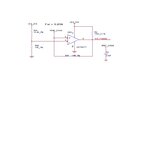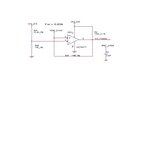anandss
Newbie
Hi,
I have observed the following problems during our thermal cycle testing on our Hardware.
1.The comparator we are using is LM139APT with operating temperature from -55°C to +125°C, and TSSOP .We are using for the Over-voltage monitoring for different voltages.
.We are using for the Over-voltage monitoring for different voltages.
The ckt description is as given below:
a.To the inverting input pins the monitoring voltages (3V3,5V,15V,-15V) are connected through resistor divider.
b.To the Non-inverting pins ,we have connected Vref voltage of 2.048V derived from the ADR440BRZ IC.
c. VCC+ pin 3 is 3V3
VCC - Pin 12 is GND
d.Pin 1,2,14,13 pulled high 100k res to 3.3 voltage
e.And feedback resistor of 10M from all o/p pins to the non-inverting input pins.
For normal voltages the output of the comparator will be High(3V3),and for overvoltages it will be Low(0V)
We have stable input voltages 3V3,5V,15V,-15V at the Inverting input pins at operating temperature from -40°C to +75°C,
But we are seeing that the comparator is not working properly(always low) above -20°C.
As mentioned the monitoring voltages(3.3V,5V,15V,-15V) are stable
Also schematics are attached.
So what may be the possible reasons for the comparator not working above -20°C?
I have observed the following problems during our thermal cycle testing on our Hardware.
1.The comparator we are using is LM139APT with operating temperature from -55°C to +125°C, and TSSOP
 .We are using for the Over-voltage monitoring for different voltages.
.We are using for the Over-voltage monitoring for different voltages.The ckt description is as given below:
a.To the inverting input pins the monitoring voltages (3V3,5V,15V,-15V) are connected through resistor divider.
b.To the Non-inverting pins ,we have connected Vref voltage of 2.048V derived from the ADR440BRZ IC.
c. VCC+ pin 3 is 3V3
VCC - Pin 12 is GND
d.Pin 1,2,14,13 pulled high 100k res to 3.3 voltage
e.And feedback resistor of 10M from all o/p pins to the non-inverting input pins.
For normal voltages the output of the comparator will be High(3V3),and for overvoltages it will be Low(0V)
We have stable input voltages 3V3,5V,15V,-15V at the Inverting input pins at operating temperature from -40°C to +75°C,
But we are seeing that the comparator is not working properly(always low) above -20°C.
As mentioned the monitoring voltages(3.3V,5V,15V,-15V) are stable
Also schematics are attached.
So what may be the possible reasons for the comparator not working above -20°C?
